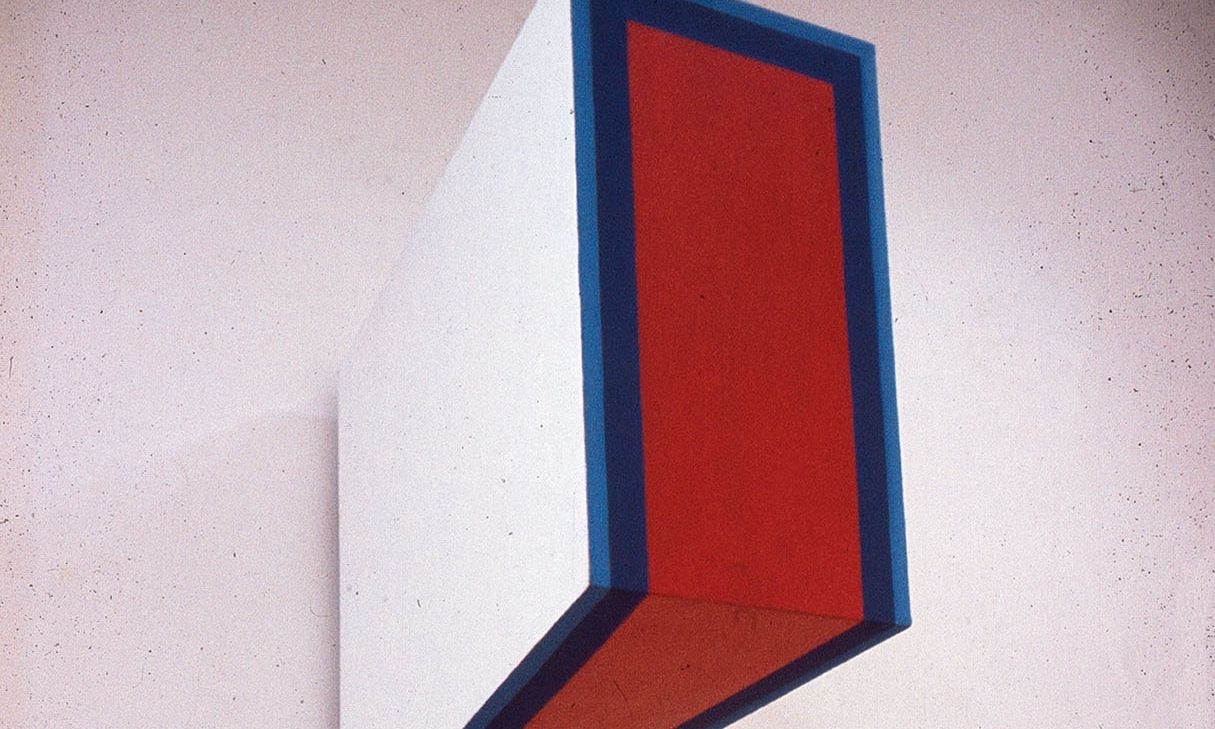Red Carpet (1965) was one of the three-dimensional “shaped canvases” from Richard Smith’s Sphinxes series Courtesy of Richard Smith Foundation
In autumn 1959 Richard Smith (1931-2016) made his inaugural visit to America, sailing by liner from Southampton to New York, where he soon sought out Ellsworth Kelly, whose hard-edge abstract canvases he had admired at the American embassy in London. Funded by a Harkness Fellowship award, Smith remained in America for 21 months, during which he met many other artists, among them Frank Stella (they became lifelong friends), Robert Indiana and Kenneth Noland, to whom he was introduced by the critic Clement Greenberg. Smith set up a studio in downtown New York. There he made paintings that constituted his first ever solo show, at the city’s Green Gallery in April 1961, a show facilitated following recommendation by the Metropolitan Museum of Art curator Henry Geldzahler.
Smith was the first British artist of his generation to spend a sustained period of time in the US. On his return to London in late 1961, the 30-year-old Smith, wearing American jeans and button-down shirts, appeared—as David Alan Mellor, emeritus professor of art history at the University of Sussex, writes in this first, much anticipated monograph on the artist—as “the personification of self-aware modernity, in a capital city just waking from the post-Imperial crisis of Suez”.
Mellor’s is one of four essays in the book, each considering Smith from a different vantage point. The artist Alex Massouras contributes two essays, and there is a coda by the book’s editor, Martin Harrison. The first and most substantial text is by Chris Stephens, a former senior curator at the Tate and now the director of the Holburne Museum in Bath, who, in a detailed analysis of Smith’s career, states that by 1962, the year of the artist’s solo show at the ICA, London, he had become an art world celebrity.
Smith’s fascination with American popular culture developed when studying painting at the Royal College of Art (1954-57). Both cerebral and sensuous, it was driven equally by a semiotic analysis informed by texts such as Marshall McLuhan’s 1951 critique of advertising techniques The Mechanical Bride, and by a fan’s passion for movies, fashion and music. Smith’s work of the 1960s is remarkable for its assimilation of the graphic iconography of American consumerism within a language of painterly abstraction inspired by Rothko and Sam Francis.
In New York he became fascinated by its metropolitan spectacle of billboards and neon signs, and by wide-screen Cinemascope, which he described as “a new experience of pictorial space”. His abstracted motifs derived from magazine adverts, hoardings and cinema screens, “which never present objects actual size: you could drown in a glass of beer, live in a semi-detached cigarette pack.”
Such observations resulted in experimentation with shaped canvases and included three-dimensional structures that protrude outwards from the wall. The lush hues of Smith’s pigment, backlit by the white of the canvas, are those of film and advertising photography, and his titles those of brand-names, such as Panatella and Revlon, or refer to types of packaging; for instance, Flip Top and Gift Wrap.
Smith lived in America for much of the 1960s, steadily gaining acclaim internationally, with successes at the 1966 Venice Biennale and the following year’s Bienal de São Paolo, where he was awarded the Grand Prix. But as the Vietnam War escalated, so too did the disillusionment he and his American wife, Betsy Scherman, felt with the US, and in 1968 they moved with their infant son to rural Wiltshire, where Smith set up a studio.
There, his works’ emotional tenor changed. In contrast to the dazzling palette of the American paintings, it became generally more restrained and monochromatic, its external reference points more obtuse. The exploration of scale continued, in very large works formed of two or more canvases. And, given the dramatic architectonics of Smith’s work, it is intriguing to read in this book of his early ambition to study theatre design, of his lifelong interest in the Modernist stage designs of Edward Gordon Craig and Adolphe Appia.
A further development came in the early 1970s, with what became known as the kite paintings; canvases stretched, not on traditional wooden frames, but on structures formed from aluminium rods, and held in place with string ties that remained visible, as intrinsic elements of the work. Formed in geometric or irregular shapes, they were suspended directly on the wall or from the ceiling. Here, as Massouras writes, Smith’s interest in movement “became actually dynamic, endlessly rearranged by the vagaries of shadows, currents of air, and gravity”. Often commissioned for airports and malls, the kites became grander in scale and complexity, more openly expressive in pattern and colour.
Long returned to New York, Smith resumed easel painting around 1993, his uniform divisions of the picture plane reminiscent of the formal symmetries of his first American works. Again both graphic and painterly, and combining dynamic compositional structures with richly layered colour, these are among the most convincing and attractive paintings of this important artist’s career. This handsome, well-illustrated volume forms a significant marker in Smith’s recent critical rehabilitation, one that would doubtless be consolidated by a substantial retrospective.
• Richard Smith: Artworks 1954-2013, by Chris Stephens, David Alan Mellor, Alex Massouras and Martin Harrison. Published by The Estate of Francis Bacon Publishing, 272pp, 250 colour illustrations, £60 (hb)

